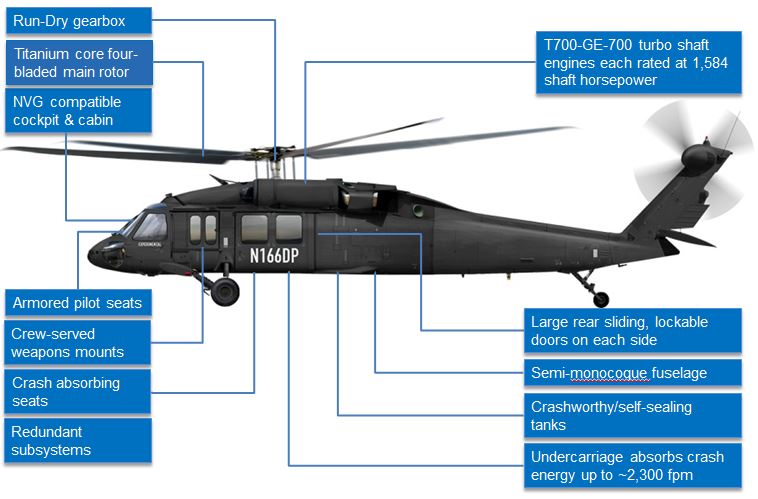Understanding the Mechanics and Engineering Behind Uh 60 Helicopters
The UH-60 helicopter, commonly referred to as the Black Hawk, stands as a pinnacle of modern rotorcraft innovation, personifying a blend of robust design and detailed mechanics. From its inception to its present models, the advancement of this aircraft showcases a blend of advancement and usefulness. As we peel back the layers of the UH-60's style, a world of intricate systems and careful engineering comes to light. Recognizing the mechanics and design behind this functional aircraft introduces a realm where accuracy satisfies power, and where each element plays an important function in accomplishing trip.
Background of UH-60 Helicopters
The background of UH-60 helicopters traces back to the late 1970s when the USA Army sought a versatile and advanced utility helicopter to change its aging fleet. In feedback to this demand, the Sikorsky Aircraft Firm created the UH-60 Black Hawk helicopter. Introduced in 1979, the UH-60 rapidly became a staple in army procedures due to its excellent capacities.
The UH-60 was made to master a variety of objectives, including army transportation, clinical evacuation, digital war, and special procedures. Its capacity to adjust to different duties made it a useful asset to the united state Army and various other military forces worldwide
Throughout the years, the UH-60 system has undertaken several upgrades and variations to improve its efficiency and equal developing goal requirements. These helicopters have actually seen comprehensive solution in conflicts such as the Gulf Battle, Afghanistan, and Iraq, showcasing their reliability and adaptability in diverse operational settings. The UH-60's rich history is a testimony to its enduring tradition as a top utility helicopter.

Engine and Power Systems
Utilizing cutting-edge propulsion technology, UH-60 helicopters are outfitted with innovative engine and power systems to make sure ideal performance and reliability in a series of functional scenarios. The UH-60, commonly recognized as the Black Hawk, is powered by two General Electric T700-GE-701D engines, each efficient in supplying up to 1,940 shaft horsepower. These turboshaft engines provide the essential drive for the helicopter to execute its goals properly, including army transportation, medical discharge, and battle support.

Rotor System and Aerodynamics
How do the blades system and the rules of aerodynamics of UH-60 helicopters contribute to their operational performance and flight capabilities? The blades system of the UH-60 helicopter Check This Out plays a critical function in offering lift and propulsion.
The rules of aerodynamics likewise play an essential duty in the efficiency of UH-60 helicopters. The structured body and rotor blade layout decrease drag, allowing the helicopter to attain greater rates and much better fuel performance. The aerodynamic design of the UH-60 additionally contributes to its capacity to operate in varied environmental problems, including hot temperature levels and high altitudes.
Avionics and Trip Control Systems

In its elaborate sychronisation with the blades system and the rules of aerodynamics of UH-60 helicopters, the avionics and flight control systems develop a critical network of technologies shaping the aircraft's functional capacities. In the UH-60, these systems consist of electronic displays, communication radios, GPS navigating, climate radar, and auto-pilot systems.
The flight control systems of the UH-60 are accountable for translating the pilot's inputs into the suitable changes to the blades system, making sure steady trip and ability to move. These systems are composed of hydraulic actuators, servos, linked here and computer systems that interact to regulate the major and tail blades, along with various other trip control surface areas. By specifically taking care of the helicopter's trip characteristics, these systems allow pilots to do a wide variety of objectives, from transport and search-and-rescue to fight operations, with precision and confidence.
Duty and Applications in Aeronautics
The duty and applications of avionics and trip control systems in air travel are important to making certain the reliable and risk-free operation of aircraft, consisting of UH-60 helicopters. Avionics systems in UH-60 helicopters incorporate a series of electronic systems that aid in navigating, interaction, monitoring, and controlling numerous airplane functions. These systems consist of electronic screens, autopilot systems, interaction radios, GPS navigation tools, and weather condition radar. Flight control systems play an important role in steering the helicopter airborne, maintaining security, and making sure precise activities. The fly-by-wire modern technology utilized in modern UH-60 helicopters equates pilot inputs into digital signals, which are then interpreted by the trip control computer systems to adjust the airplane's control surface areas. Additionally, these systems include security features such as auto-pilot modes, terrain awareness cautioning systems, and stability enhancement systems to improve the general safety and operational abilities of the UH-60 helicopters in different objectives, consisting of army transport, medical emptying, search and rescue, and aerial firefighting.
Final Thought
In verdict, the UH-60 helicopter is a versatile aircraft with a rich background and progressed design. Its engine and power systems, blades system, aerodynamics, avionics, and flight control systems all work together to make it a efficient and reputable equipment. The UH-60's duty and applications in aeronautics are vast, ranging from military operations to search and rescue missions. Its continued development and use demonstrate its significance in the field of aviation (uh additional reading 60).
In its complex sychronisation with the rotor system and aerodynamics of UH-60 helicopters, the avionics and trip control systems create a crucial network of technologies forming the airplane's operational capabilities.The trip control systems of the UH-60 are liable for equating the pilot's inputs into the appropriate changes to the rotor system, ensuring steady flight and ability to move. Avionics systems in UH-60 helicopters include an array of digital systems that help in navigation, interaction, surveillance, and managing different aircraft functions. Furthermore, these systems integrate safety features such as auto-pilot modes, surface recognition advising systems, and security augmentation systems to enhance the total security and functional capabilities of the UH-60 helicopters in numerous objectives, including army transport, clinical evacuation, search and rescue, and airborne firefighting.
Its engine and power systems, rotor system, the rules of aerodynamics, avionics, and flight control systems all work together to make it a trustworthy and effective machine.